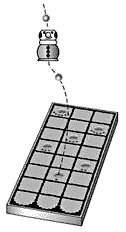|
|
PDF-Rules: Welcome to the Circus (510kb)  A clever game for 2 to 4 players aged 6 years and up 
Game material
Setting up the game All three clowns are placed next to each other on the three
start spaces at the bottom of the game board. Each player
selects a colour and takes the three balls in that colour. With
fewer than four players the remaining balls are left in the
box, for later use. The start player, who is chosen randomly,
takes the coloured dice.
All three clowns are placed next to each other on the three
start spaces at the bottom of the game board. Each player
selects a colour and takes the three balls in that colour. With
fewer than four players the remaining balls are left in the
box, for later use. The start player, who is chosen randomly,
takes the coloured dice.
Object of the gameThe balls should get in the holes in the board. If a ball of a player 's own colour falls into a hole, that player receives the appropriate number of points. The number of points is indicated by the asterisks under the respective hole. The player who has most points at the end of the game is the winner.How the game is playedThe player whose turn it is rolls the coloured dice. That player then either brings a ball of the colour rolled into play or moves one of the clowns. Then it is the next player's turn.Bringing a ball into the gameThe player puts a ball of the colour rolled into any clown. For example, if the player has rolled red then he puts a red ball into one of the clowns, even if that player is the owner of the green or yellow balls. However if all of the red balls are already in the game this option is no longer possible.It does not matter whether the clown is still on the starting space or if it has already been moved. Each clown can hold a maximum of three balls at a time. If a player rolls either black or white, then that player may choose whichever colour he likes. To move a clownThe player may move a clown whose upper ball matches the colour rolled. To identify which is a clown's top coloured ball, the player simply looks into the clown from above. For example, if the player has rolled blue, he moves a clown whose upper ball is blue. If the player rolls either black or white, he may select any clown. A player may only move one clown during their turn, even if several upper balls match the colour rolled.The clowns may be moved forward or sideways in any combination, but not diagonally. Additionally a clown may not turn around within a move, i.e. the clown may not move directly back to a space over which it has already passed during that turn:   The length of the move depends on the number of balls which the clown is carrying. With one ball the clown only moves one space, with two balls he moves two spaces and with three he even moves three spaces. If possible, the full movement must be made. Normally clowns do not move backwards, however if a player throws black he may move a clown back towards the start spaces. There may be only one clown at each space. A space already occupied by other clowns can not be crossed. Special situationsThe length of the move isn't changed if the clown moves across a hole and looses a ball. The change in the length of the move which the clown can make is not applied until it 's next move.The clowns may stand on the holes. If a player cannot either move a clown or bring another ball into play, then that player loses his turn and play moves on to the next player. Game endThe game ends as soon as a ball lands in the last hole (6 points),even if not all of the other holes are filled yet.Calculating the WinnerEach player adds the points for the balls of his colour. The one with the most points is the winner.Optional rules and suggestions for pros
|
|
 |
   
Bambus Spieleverlag Günter Cornett | Kopfstraße 43 | D-12053 Berlin Phone/Fax: +49-30-6121884 |
| just archiv data +++ no orders +++ German infos Archiv-Seite +++ nicht aktuell +++ keine Bestellungen! Infos hierzu sowie aktuelles Impressum: www. bambusspieleverlag. de |
